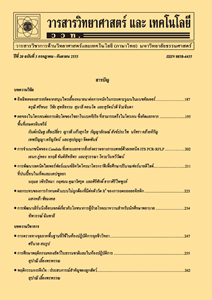รูปแบบการไหลเวียนกระแสน้ำในอ่าวไทยจากแบบจำลอง
Main Article Content
Abstract
บทคัดย่อ
บทความนี้เป็นบทความที่นำเสนอรูปแบบการไหลเวียนของกระแสน้ำในอ่าวไทยโดยใช้ผลจากการทบทวนงานวิจัยตามประเภทของการศึกษา 2 รูปแบบ คือ (1) รูปแบบการไหลเวียนกระแสน้ำจากแบบจำลองกระแสน้ำโดยใช้ข้อมูลลมและน้ำขึ้น-น้ำลง (2) รูปแบบการไหลเวียนกระแสน้ำจากแบบจำลองกระแสน้ำโดยใช้ข้อมูลลม อุณหภูมิและความเค็มเป็นข้อมูลนำเข้าในแบบจำลอง ผลจากการทบทวนพบว่ารูปแบบการไหลเวียนกระแสน้ำที่ได้จากแบบจำลองกระแสน้ำทั้ง 2 รูปแบบ มีลักษณะที่คล้ายคลึงกัน คือ ช่วงมรสุมตะวันออกเฉียงเหนือกระแสน้ำไหลเข้าทางด้านใต้ของอ่าวและไหลออกจากอ่าวไทยทางฝั่งตะวันออก และในบริเวณอ่าวไทยตอนบนพบว่ากระแสน้ำมีลักษณะการไหลแบบทวนเข็มนาฬิกา ในช่วงเปลี่ยนฤดูมรสุม (มีนาคม-เมษายน) กระแสน้ำไหลเข้าทางด้านใต้ของอ่าวและไหลออกทางฝั่งตะวันออก ช่วงมรสุมตะวันตกเฉียงใต้กระแสน้ำไหลเข้าทางด้านใต้ของอ่าวและไหลเลียบขึ้นไปตามแนวชายฝั่งด้านตะวันตกของอ่าว และไหลวนตามเข็มนาฬิกาแล้วไหลออกทางด้านตะวันออกของอ่าวไทย ส่วนในช่วงเปลี่ยนฤดูมรสุม (ตุลาคม) กระแสน้ำเริ่มเปลี่ยนทิศทางคือกระแสน้ำไหลเข้าทางด้านตะวันออกและไหลออกทางด้านใต้ของอ่าว
คำสำคัญ : การไหลเวียนกระแสน้ำ; อ่าวไทย; แบบจำลอง
Abstract
This article reviews circulation patterns in the Gulf of Thailand investigated using hydrodynamic models by using (1) wind and tide data and (2) wind, sea surface temperature and salinity data as model inputs. The reviews show that circulation patterns from both approaches are similar. During the northeast monsoon, current flows into the gulf in the south and flows out in the east of the gulf. The current turns counter-clockwise in the upper gulf region. Current still flows into the gulf in the south and flows out near the eastern coast during the first transition monsoon period (March-April). During the southwest monsoon, current flows into the gulf in the south and along the western side of the gulf, and flows out of the gulf in the eastern side. A clockwise circulation develops in this season. Current starts to change directions by flowing into the gulf in the east and out of the gulf in the south during the second transition monsoon period (October).
Keywords: circulation; Gulf of Thailand; model


